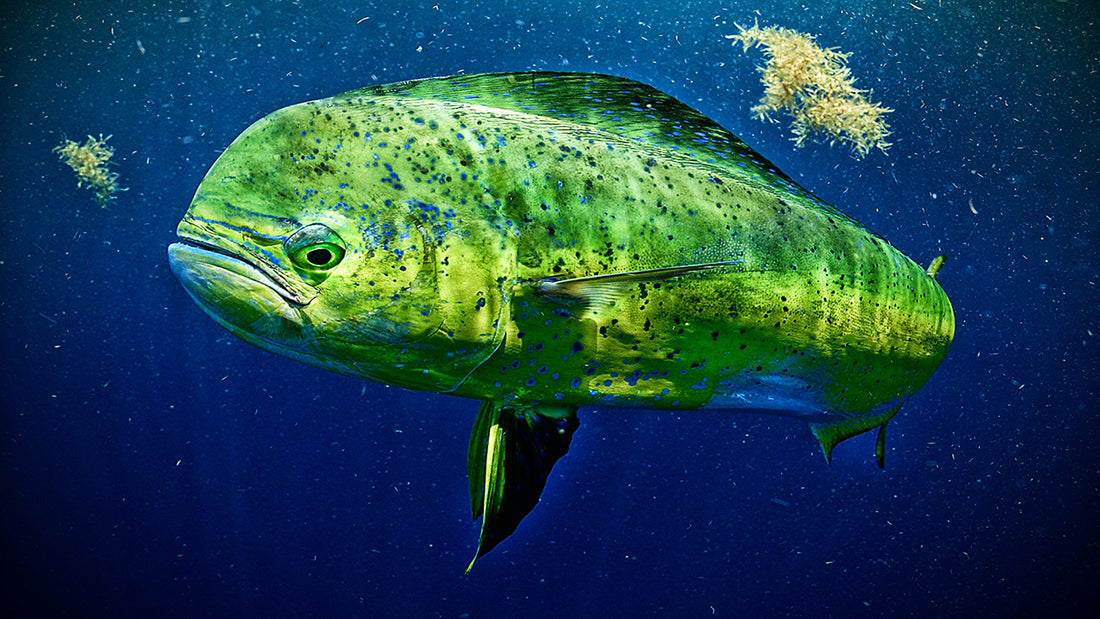
Species Spotlight: Mahi Mahi
MAHI MAHI(Dorado, Dolphin, Dolphinfish)
Coryphaena hippurus

Without question, the mahi is truly one of the world’s greatest gamefishes. Aggressively slamming lures and baits at or just under the surface (and sometimes stubbornly refusing to do so); repeatedly and amazingly launching into high-jumping acrobatics when hooked; flashing the most astounding array of neon yellows, greens and blues; and even offering outstanding fillets for the connoisseur — the mahi has it all. The rapacious pelagic predator also has a completely circumglobal presence in blue, offshore waters of all warm/tropical oceans, with a mind-blowing growth rate (up to 18 inches in one year). Except for a very small, similar species known as the pompano dolphin, C. hippurus is the only species in its family, Coryphaenidae.
Appearance
Laterally compressed (as if squeezed flat), the mahi is very elongate with a prominent, high, nearly full-length dorsal fin and a large, deeply forked tail. Its electric hues, noted above, change — often instantly and dramatically — per its mood. Juveniles and females have a rounded head, where as fully mature adult males (“bulls”) develop a pronounced high, squared-off head.

Habitat
Mahi are fishes of the open ocean, though on occasion they may wander into nearshore coastal waters. They’re prone to associate with any bluewater “structure” such as sargassum weed lines or any floating flotsam, large or (sometimes surprisingly) small. Hundreds of brilliant blue mahi, especially smaller fish of 2 to 10 pounds or so, may surround one log.
Size
Commonly caught from a mere pound or two to 50 or more. Anglers in the Southeast often use specific names to categorize C. hippurus by size, from “peanuts” of a few pounds to “slammers” of 40 or more. Smaller fish tend to form large schools; as they get much older they often travel in small packs; the largest tend to be solitary. The IGFA all-tackle world record, set back in 1976 off Papagayo in northern Costa Rica, weighed 87 pounds (on a trolled plastic squid).
Pros
As noted above, could well be the perfect gamefish: aggressive, lightning-fast, acrobatic, gorgeous. They’re ubiquitous and at times easy to locate for flurries of non-stop action.
Cons
Since they’re fishes of blue water, coastal and inland anglers may not have an opportunity to hook these amazing speedsters.

Pro’s Tips for Targetting Mahi Mahi
A lifetime of catching mahi in the Pacific, Atlantic and Indian oceans, with some great skippers, leads to a few suggestions for mahi anglers – doug.
- Go light and be ready!I've seen too many mid-size mahi basically cranked in on heavy tackle by angler in a chair after the fish hit a high-speed lure trolled for billfish. Anyone fishing blue water should have light spinning, baitcast and/or fly rods rigged and ready with jigs, spoons, lures and/or unweighted circle hooks (for bait) to throw when mahi are encountered. On light gear, they’re amazing combatants. Once fish are spotted, casting from a drifting boat for them and watching them chase down your lure offers some of fishing’s most exciting moments.
- "Leave em in the water!""Leave a hooked fish in the water when a school is about. Other mahi will remain, looking for food.
- Try a stickbait but have options.A fast-sinking stickbait — with inline single hooks; a mahi in the cockpit with a mouthful of big trebles is asking for big trouble! — will cast a long way giving you time to work it back to the boat as fast and erratically as you can. However, have other options handy including bait (even dead bait can entice), since after a few are caught on lures, the others may develop lockjaw, requiring you to change up the menu.
- Don’t hesitate to do some hatch-matching employ sabikis or a cast net, especially around weeds or flotsam where schools of little juvie jacks and even filefish are thick. Any of these put out with a hook is likely to get gobbled by mahi.
- Limit your takeIt’s so easy to get caught up in the chaos (and it is chaotic!) of several anglers bailing schoolies over the side that if no one keeps track or limits the harvest, a boat can wipe out a school and may end up with far more baby mahi than it really wants. Catch and release is, frankly, tough with mahi. Best to enjoy the action for a while but then pull up stakes and leave the school.






